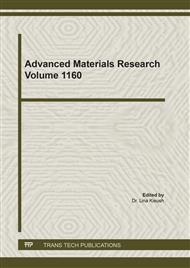[1]
Saber Fallah and Mahdi Nematzadeh Mechanical properties and durability of high-strength concrete containing macro-polymeric and polypropylene fibers with nano-silica and silica fume, Construction and Building Materials, Vol 132, p.170– 187, (2017).
DOI: 10.1016/j.conbuildmat.2016.11.100
Google Scholar
[2]
I.M. Mousa, Flexural behaviour and ductility of high strength concrete (HSC) beams with tension lap splice,. Alexandria Eng. J. 54(3) p.551–563, (2015).
DOI: 10.1016/j.aej.2015.03.032
Google Scholar
[3]
H.J. Lee, Predictions of curvature ductility factor of reinforced concrete beam sections used high strength concrete and steel,. J. Korean Soc. Civil Eng. 33(2) pp.483-493, (2013).
DOI: 10.12652/ksce.2013.33.2.483
Google Scholar
[4]
I.A. Ovid'ko, R.Z. Valiev, Y.T. Zhu, Review on superior strength and enhanced ductility of metallic nanomaterials,, Progress in Materials Science94, p.462–540, (2018).
DOI: 10.1016/j.pmatsci.2018.02.002
Google Scholar
[5]
D.Vivek, Behaviour of Nano Silica in Tension Zone of High Performance Concrete Beams,, Earth and Environmental Science No.80, pp.2017-2028,( 2018).
DOI: 10.1088/1755-1315/80/1/012028
Google Scholar
[6]
Ehsan Mohseni, Farzad Naseri, Microstructure and durability properties of cement mortars containing nanoTiO2 and rice husk ash,, Construction and Building Materials, No.114, pp.656-662, (2016).
DOI: 10.1016/j.conbuildmat.2016.03.136
Google Scholar
[7]
Alireza khaloo, Influence of different types of nano-SiO2 particles on properties of high-performance concrete,, Construction and Building Materials, No.113, p.188–201, (2016).
DOI: 10.1016/j.conbuildmat.2016.03.041
Google Scholar
[8]
Anwar M. Mohamed, Influence of nano materials on flexural behavior and compressive strength of concrete,, Housing and Building National Research Center (HBRC), Egypt November (2014).
Google Scholar
[9]
M. Ltifi, A. Guefrech, P. Mounanga, A. Khelidjb.,Experimental study of the effect of addition of nano-silica on the behaviour of cement mortars Procedia engineering,, p.900–905, October (2011).
DOI: 10.1016/j.proeng.2011.04.148
Google Scholar
[10]
Mosad Mohamed Sadawy and Eltohamy Rabie Elsharkawy Effect of Nano-Tio2addition on Mechanical Properties of Concrete and Corrosion Behavior of Reinforcement Bars, Vol. 6, Issue 10, (Part -1), pp.61-65, October (2016).
Google Scholar
[11]
S Sanju, S Sharadha and J Revathy,Performance on the Study of Nano Materials for the Development of Sustainable Concrete, Volume 09, No. 03, pp.294-300, (June 2016).
Google Scholar
[12]
Abdul Rahim and Sandanu. R.Nair Influence of Nano-Materials in High Strength Concrete, Issue 3, pp.15-22 August (2016).
Google Scholar
[13]
P. Jaishankar and K. Saravana Raja Mohan,Influence of Nano particles in High Performance Concrete (HPC), Vol.8, No.6, pp.278-284, (2015).
Google Scholar
[14]
Yuvaraj Shanmugasundarametal Behavioural Investigation on the use of Nanosilica as An Additive in Concrete, Vol. 3, No. 1, pp.6-12, October (2013).
Google Scholar
[15]
L. Gustavsson, A. Joelsson, Life cycle primary energy analysis of residential buildings,, Energy Buildings 42, p.210–220, February (2010).
DOI: 10.1016/j.enbuild.2009.08.017
Google Scholar
[16]
G.A. Blengini, T. Di Carlo,The changing role of life cycle phases subsystems and materials in the LCA of low energy buildings,, Energy Buildings 42, p.869–880, June (2010).
DOI: 10.1016/j.enbuild.2009.12.009
Google Scholar
[17]
S.I. Zaki et al., The use of nano-composites to develop the microstructure and impermeability of high performance concrete,, The 19th International Conference on Composites Nano Engineering, Shanghai, China, (2011).
Google Scholar
[18]
J. Sridhar, D. Vivek, D. Jegatheeswaran,Mechanical and Flexural Behavior of High Performance Concrete Containing Nano Silica,, International Journal of Engineering and Advanced Technology (IJEAT), Volume-9 Issue-2, December, (2019).
DOI: 10.35940/ijeat.b3164.129219
Google Scholar
[19]
Mohamed Amin, Effect of using different types of nanomaterials on mechanical properties of high strength concrete,,, Construction and Building Materials, No.80, p.116–124, (2015).
DOI: 10.1016/j.conbuildmat.2014.12.075
Google Scholar
[20]
Mahdi M.A. The Effect of Using Nano Materials on the Properties of Cement Paste and Mortar. M.Sc Thesis on Structural Department, Faculty of Engineering, Cairo University, Egypt, September (2015).
Google Scholar
[21]
Ata El-kareim Shoeib and Anwar M. Mohamed Studying effect of nanoparticles on the behavior of concrete,,1st International Conference on Innovative Building Materials, Dec. 28-30, (2014).
Google Scholar
[22]
Egyptian Standards–Building Materials Committee: cement part1: Composition, specification and Conformity Criteria for common Cement (ES 4756-1) Egyptian Organization For Standard and Quality (EOS), Cairo (2013).
Google Scholar
[23]
Egyptian Standards–Building Materials Committee: Aggregates for Concrete (ES1109), Egyptian Organization For Standard and Quality (EOS), Cairo (2008).
Google Scholar
[24]
Egyptian Standards–Ferrous Products Committee: Steel for the Reinforcement of concrete part1: Plain Bars (ES 262-1) Egyptian Organization for Standard and Quality (EOS), Cairo (2015).
Google Scholar
[25]
Egyptian Standards–Ferrous Products Committee: Steel for the Reinforcement of concrete part2: Ribbed Bars (ES 262-2) Egyptian Organization For Standard and Quality (EOS), Cairo (2015).
Google Scholar
[26]
Egyptian Code Committee: Egyptian Code for Design and Construction of Concrete Structures (ECP 203-2007) Housing and Building National Reserch Center (HBRC, Cairo (2015).
Google Scholar


